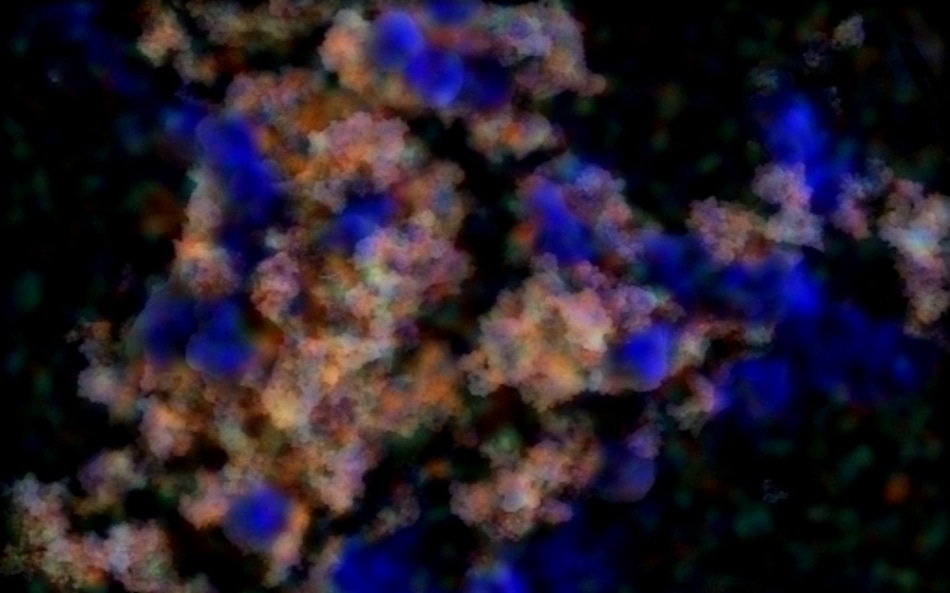Oct 25 2017
Nanotechnology has a significant role in eliminating toxic chemicals from the soil. At present, over 70 Environmental Protection Agency (EPA) Superfund sites are adopting or investigating the use of nanoparticles to degrade or eliminate environmental pollutants.
One such nanoparticle, namely, nano-zero-valent iron, has been largely applied, despite the fact that its impact on organisms has not been investigated yet.
 Cadmium (green) was mostly adsorbed to FeSSi (orange) and not algae (blue). CREDIT: SAGE DAVIS
Cadmium (green) was mostly adsorbed to FeSSi (orange) and not algae (blue). CREDIT: SAGE DAVIS
In a latest experiment, a research team from UC Santa Barbara investigated the impact of sulfurized nano-zero-valent iron, or FeSSi, on a common type of freshwater alga—Chlamydomonas reinhardtii. The team discovered that FeSSi absorbed cadmium from a watery medium and relieved the alga from cadmium toxicity for over a month. The outcomes of the research have been reported in the ACS Nano journal.
However, when FeSSi was doing what it was designed to do, we found it was up to 10 times more toxic when bound to cadmium than without. The current standards for what is an acceptable concentration to use are based on data from the particle itself unbound to the contaminant. Our work suggests that those allowable limits potentially could be huge underestimations of the actual toxicity.
Louise Stevenson, Lead Author of the study and Postdoctoral scholar, Department of Ecology, Evolution and Marine Biology (EEMB), UCSB
In order to reproduce a precipitation event where toxic material in soil is washed into a water body, the Researchers administered C. reinhardtii with the cadmium-laced FeSSi and took the measurements after an hour. They discovered that organic material synthesized by the alga as a photosynthesis byproduct alleviated the toxicity of FeSSi and enabled the nanoparticle to absorb nearly four times cadmium.
“The organic material makes the FeSSi particle less toxic, which allows a greater zone of remediation and increases the cadmium concentrations that can be used,” stated Stevenson. “That’s interesting because every natural system contains some organic material. Along with the toxic effect of the nanoparticles just on cell viability, we identified an important feedback between organic materials produced by the algae itself decreasing toxicity, which decreases toxicity to the algae.”
Stevenson added that the environmental impact of nanotechnology is highly context-dependent, rendering it challenging to make comprehensive predictions. Therefore, the UCSB researchers developed a dynamic ecological model that can be applied to hypothesize their empirical investigation. They gathered adequate data to formulate a sequence of equations to elucidate the dynamics of the concentrations analyzed by them.
We’re developing new technology faster than we can predict its environmental impact. That makes it very important to design experiments that are ecologically and environmentally relevant but also get at dynamics that can be extrapolated to other systems.
Louise Stevenson, Lead Author of the study and Postdoctoral scholar, Department of Ecology, Evolution and Marine Biology (EEMB), UCSB
The many-sided strategy described in the paper is the result of an interdisciplinary partnership. Stevenson is an Empirical Toxicologist and Ecological Modeler. Her Co-authors—Arturo Keller, a Professor at UCSB’s Bren School of Environmental Science & Management, and Yiming Su, a Graduate Student who visited the Keller Lab from Tongji University in Shanghai and developed FeSSi—are Environmental Chemists. Roger Nisbet, a Co-author of the paper and an EEMB Professor, is a Theoretical Ecologist. Adeyemi Adeleye, a Bren School alumni who is a National Research Council Researcher with the EPA, and Yalei Zhang from Tongji University in Shanghai are other Co-authors of the study.
The U.S. National Science Foundation, the U.S. Environmental Protection Agency, and the National Natural Science Foundation of China supported the study.